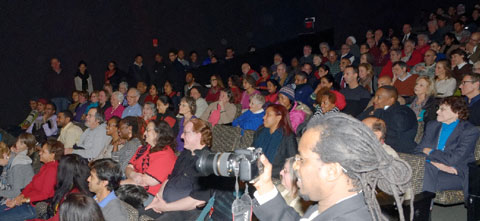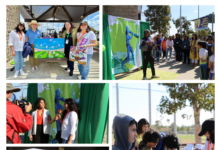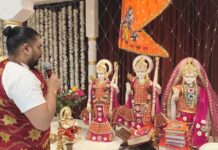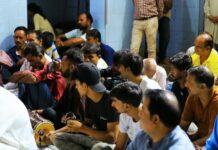CHICAGO: Local filmmaker Prashant Bhargava having the Chicago premiere of his 35-minute multimedia collaboration with New York-based composer-pianist Vijay Iyer “Radhe Radhe: Rites of Holi” had reason to be happy and both were pleasantly surprised when more than 160 viewers turned up for this event at the 128-person capacity hall at Logan Center, the University of Chicago recently.
The edited collage of video clips depicting the riotous festival as celebrated in Mathura is intended to be (re-) “performed” in live “dialogue” with external orchestra but, given the costs involved, the Chicago audience had to remain contented with the accompanying score prerecorded on DVD.

Iyer’s musical score attempts to recreate the rhythms flowing through the participants with two pianos, percussion, winds and strings combining elements of jazz, Western classical and Indian music. The buildup to the festival contrasts the meditative tranquility of the opening rustic scenes, through various preparatory activities, to the intense orgy of color and ritualized violence, itself punctuated by lyrical scenes focused on the solitary Radha, played by Anna George, longing in silence for union with her ever invisible Krishna.
Bhargava and Iyer were commissioned to produce an original piece inspired by “The Rite of Spring” to commemorate the 100th anniversary of this watershed ballet and orchestral concert work staged in Paris in 1913 by epoch-making composer Igor Stravinsky. Whereas the original conjured up a frenzied Russian pagan festival, “Radhe Radhe” comprises edited footage of actual Holi as celebrated still today in its pristine form in Braj, epicenter of the Krishna cult.
Whereas that jarring alien sensibility provoked the urbane French audience to riot, the Indian “festival of colors” is familiar by now to large swathes of the American population, increasing numbers of whom join with gay abandon in the annual celebration by the Indian Diaspora. This, perhaps inevitable, hybrid production by two US-born Indians consecrates and facilitates the cultural convergence.
“Radhe Radhe” however foregrounds for our globalized consciousness an acute “contradiction” that has remained largely hidden at the heart of this spring festival even for the Hindus, who have been re-enacting it in India for millennia, eventually with the official sanction of Lord Krishna. This was revealed in the very ambivalence with which Bhargava recounts his personal trajectory in attempting to fulfill his commission.
On the one hand, the filmmaker is intent on honoring Radha, the gateway to Krishna, to depict the festival of love authentically from the perspective of the devotees themselves. Which is also a way of honoring his grandmother, who worshipped Radha-Krishna steadfastly in their dedicated shrine at his parents’ home in Ujjain. This is why, instead of heeding Iyer’s original suggestion to film the fun-filled Diaspora Holi in New York, he headed straight to its living source in Mathura.
For most Hindus, especially those belonging to regions such as South India where the festival is not celebrated with such collective fervor, if at all, the aesthetics of Holi has become intimately familiar through artistic representations of the prankster Krishna spraying colors at the cowherdesses. Its dense cultural complex of dance, music, painting and moods that has long since captured the Indian imagination now seduces secular sensibilities across the globe. The lustful core of aphrodisiacal spring has been spiritualized into the transcendental bond between the divine couple, and Radha has been elevated into a metaphor for the embodied soul seeking union with its invisible source.
Through the thick clouds of colors thrown at us, we see the dissolving of social inhibitions-as if they had all been consumed in the giant conflagration (Holika fire) that sparks off the revelry-though it became clear afterward that the more explicit gestures of obscenity had been prudently edited out.
Platoons of women armed with staves march into town and suddenly on cue start hammering mercilessly at their menfolk cowering behind flimsy wooden shields. Though the vast majority of street-revelers are men, many women of all ages are also seen laughing and dancing with gay abandon in their midst.
The local pandits explained that with the onset of spring came this need for the relatively harmless release of pent up sexual tension. Indeed, this volcanic eruption, from within, is prefigured in the beginning ‘invocatory’ scene of the tranquil harvest fields, where we are already shown the mating ritual of two storks, the courting male dancing aggressively to show off his winged colors.
But what has all this to do with the traditional worship of Lord Krishna? Especially when this “rite of spring” is launched, programmatically, from the temple sacred to ‘queen’ Radha (-Rani)? Instead of attempting to ‘resolve’ this enigma, Bhargava resorts to the strategy of juxtaposition.
As the orgy builds up, the entirely detached but very sensuously depicted Anna George is now seen looking out of her window, breaking finally into an expectant smile. At its climax, she is being ravished from behind by the insistently groping blue hands of an unseen presence. Have the excesses of Holi been sublimated into a profound spiritual experience of Krishna, or has sweet ethereal Radha been forcibly brought back down to this earthy eruption of unbridled lust?
Even to raise, let alone explore, such perplexing questions, the “Rites of Holi” need to be contextualized, especially when thrust before wholly unprepared viewers as was the case here, where the comments revealed how completely the audience had been disoriented by what they had just seen.
The rioting Parisian audience at the 1913 premier of “Rite of Spring” had long lost touch with their own extinct heritage of the medieval carnival, which is provoking worldwide debate over the last decades. The still extant “Rites of Holi” could instead help make sense of, even resurrect, what is actually a universal legacy.
The screening was co-sponsored by Eye on India Festival, Indo-American Heritage Museum and Hyde Park Jazz Festival.
Elizabeth Vaulingam






